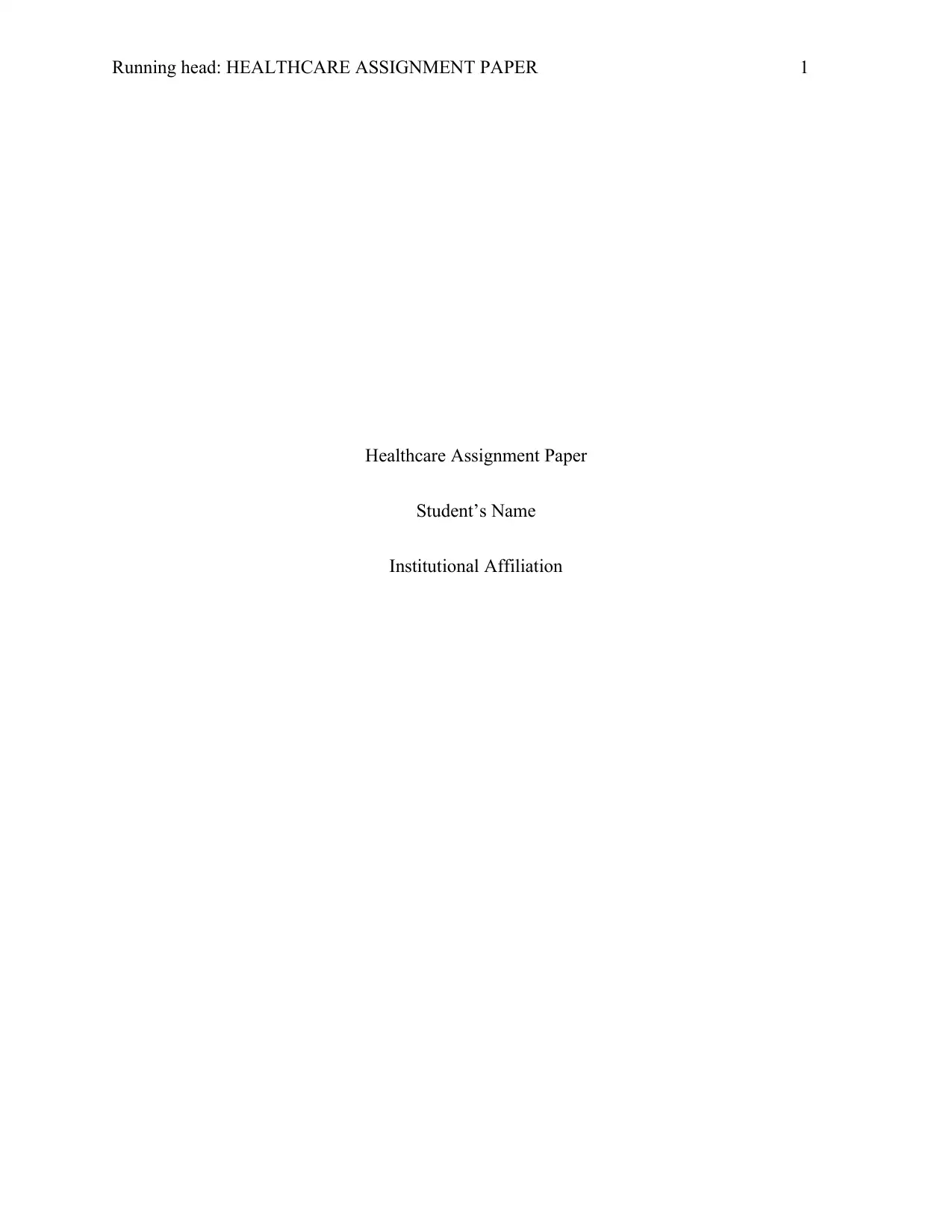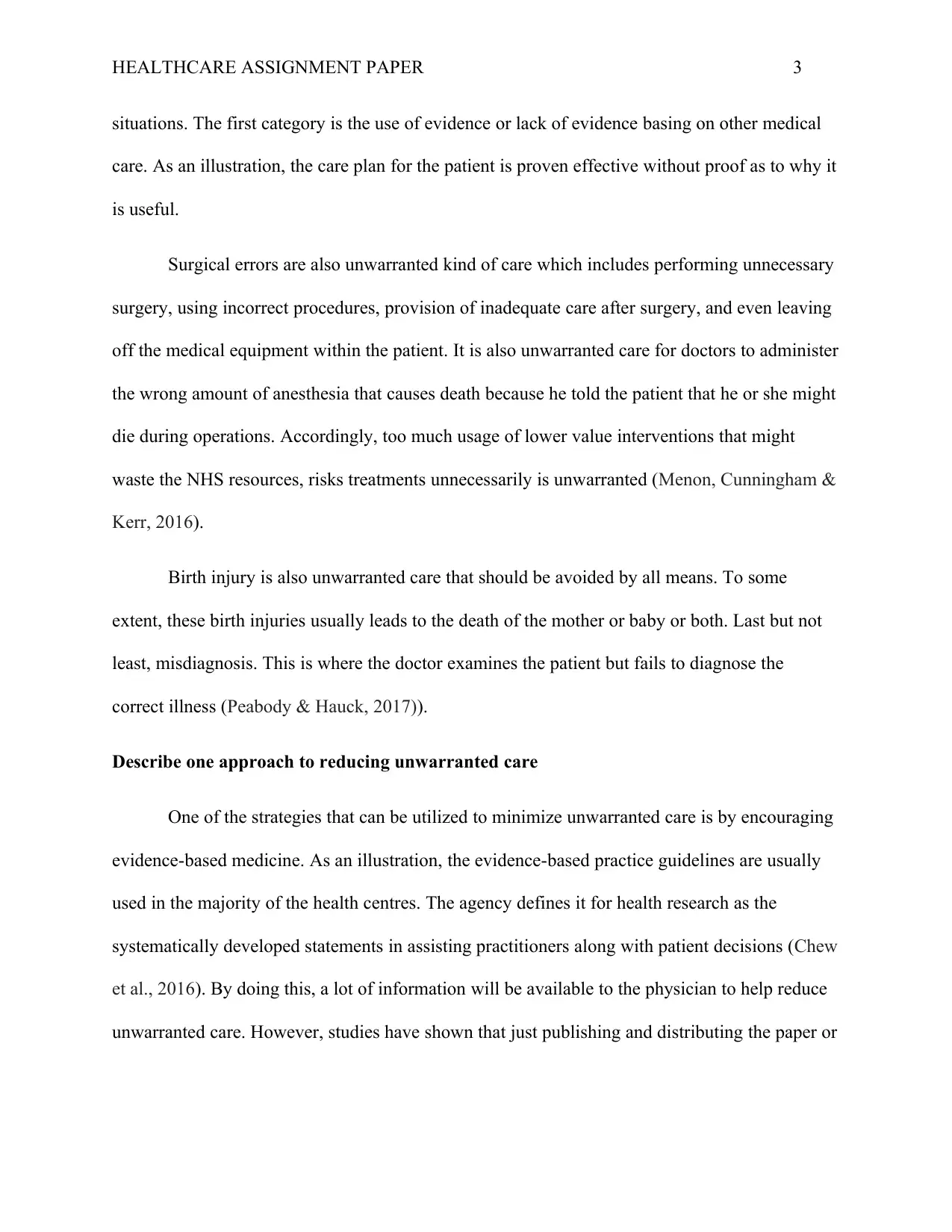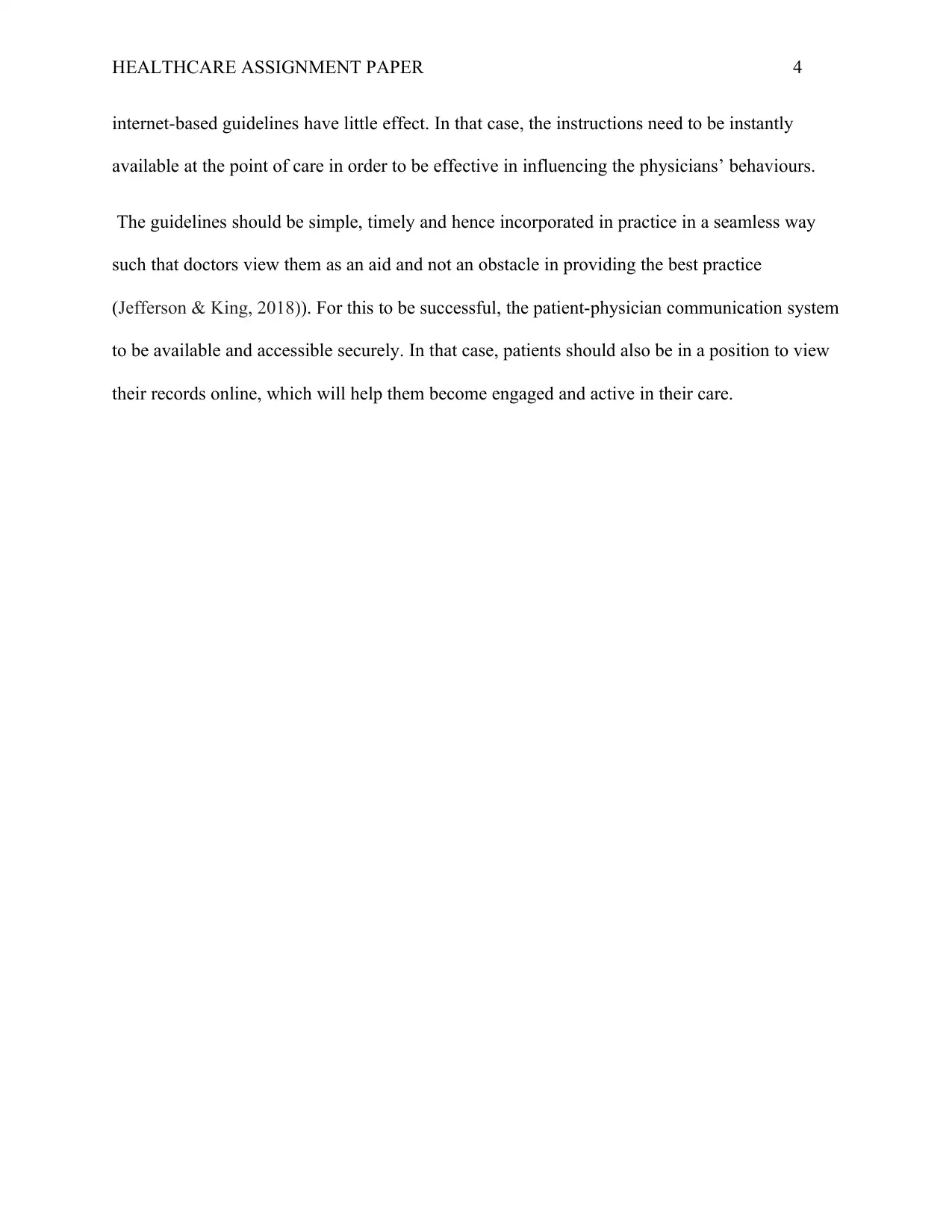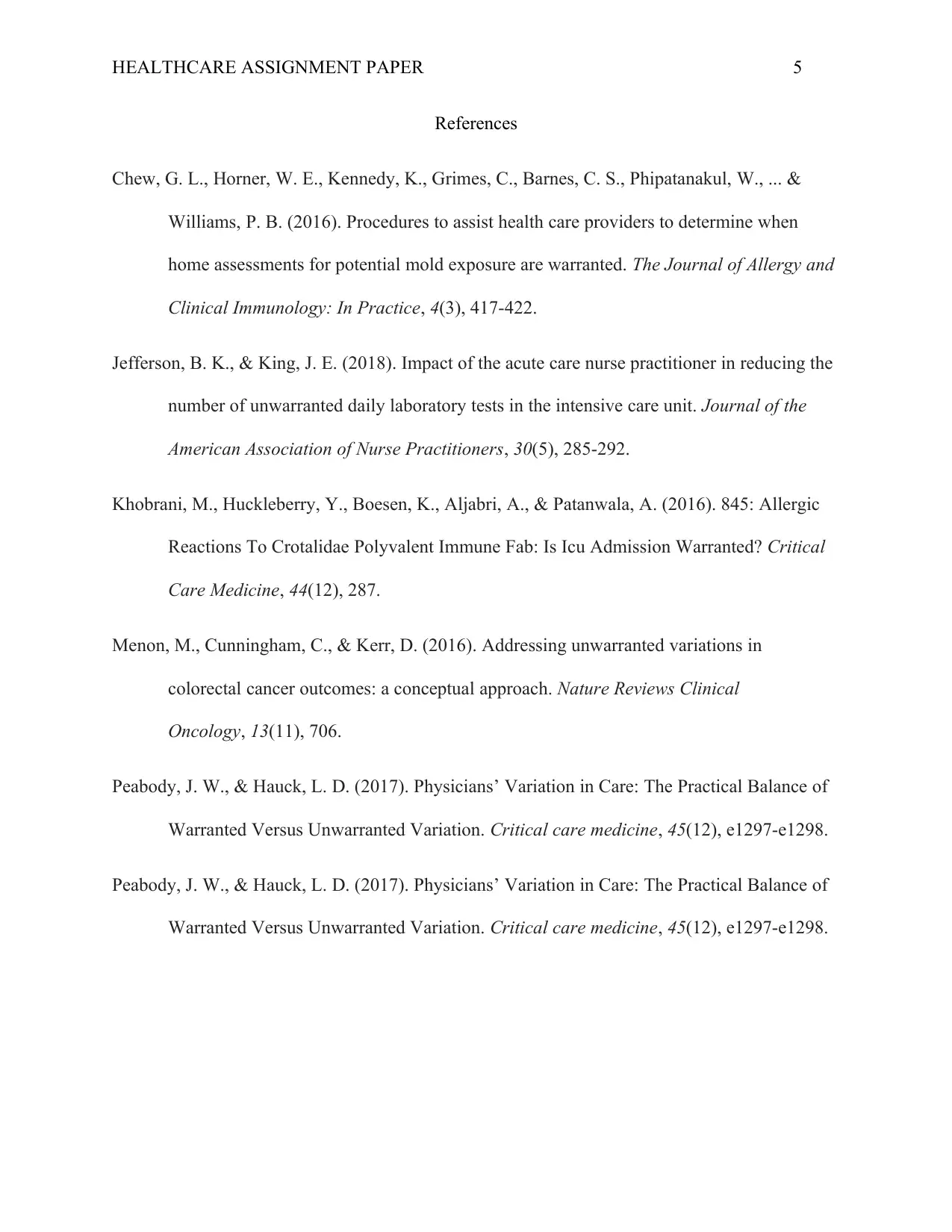Healthcare Assignment: Warranted, Unwarranted Care and Reduction
VerifiedAdded on 2022/10/15
|5
|1086
|230
Report
AI Summary
This healthcare assignment paper defines and differentiates between warranted and unwarranted care within the healthcare system. Warranted care, deemed acceptable and often driven by innovations in treatments, is exemplified by smoother discharge processes, thwarting bacteria spread, and the adoption of telehealth. Conversely, unwarranted care involves over- or undertreatment, incorrect medications, and surgical errors, often stemming from factors like lack of evidence-based practices or misdiagnosis. The paper proposes evidence-based medicine as a key strategy for reducing unwarranted care, emphasizing the importance of accessible and timely guidelines at the point of care. The patient-physician communication system should also be available and accessible securely, and patient should be able to view their records online, which will help them become engaged and active in their care.

Running head: HEALTHCARE ASSIGNMENT PAPER 1
Healthcare Assignment Paper
Student’s Name
Institutional Affiliation
Healthcare Assignment Paper
Student’s Name
Institutional Affiliation
Paraphrase This Document
Need a fresh take? Get an instant paraphrase of this document with our AI Paraphraser

HEALTHCARE ASSIGNMENT PAPER 2
Nurses and doctors usually determine the health of the nation and therefore, should be
keen on any care they give to a patient. This is because some attention typically worsens the
patients’ status while others increase the patients’ expenses in the health centre.
Define warranted and unwarranted care.
Warranted care is usually considered acceptable in any healthcare system. As an
illustration, this is a kind of care that is not just good but also desired. The warranted attention
usually occurs because of innovation in treatments or care (Menon, Cunningham & Kerr, 2016).
This includes the provision of high-value health services for all patients. Some of the warranted
attention are as highlighted below. Making the discharge process smoother. This helps to reduce
the bottlenecks and hence, steady patient flow (Peabody & Hauck, 2017). The hospitals should
implement processes which include discharge planning on date of admission in conjunction with
using checklists.
Thwarting the spread of deadly bacteria is also a good practice in healthcare nursing
along with the adoption of the telehealth in order to improve the patient outcomes. As an
illustration, it is stated that platforms which engage the patients before and after surgery usually
gets good results unlike the old approaches (Khobrani, Huckleberry, Boesen, Aljabri &
Patanwala, 2016).
The unwarranted care is where patients are over or undertreated, or treated with wrong
medications for their illness and always harmful for the patients and their families. At times
doctors usually arrive at the right diagnosis but then fails to recommend the right treatments.
These situations typically consist of malpractices which are referred to as failure to treat. These
kind unwarranted care usually occur, especially when the nurse or doctor is dealing with many
patients (Menon, Cunningham & Kerr, 2016). Unwarranted care is partitioned into three
Nurses and doctors usually determine the health of the nation and therefore, should be
keen on any care they give to a patient. This is because some attention typically worsens the
patients’ status while others increase the patients’ expenses in the health centre.
Define warranted and unwarranted care.
Warranted care is usually considered acceptable in any healthcare system. As an
illustration, this is a kind of care that is not just good but also desired. The warranted attention
usually occurs because of innovation in treatments or care (Menon, Cunningham & Kerr, 2016).
This includes the provision of high-value health services for all patients. Some of the warranted
attention are as highlighted below. Making the discharge process smoother. This helps to reduce
the bottlenecks and hence, steady patient flow (Peabody & Hauck, 2017). The hospitals should
implement processes which include discharge planning on date of admission in conjunction with
using checklists.
Thwarting the spread of deadly bacteria is also a good practice in healthcare nursing
along with the adoption of the telehealth in order to improve the patient outcomes. As an
illustration, it is stated that platforms which engage the patients before and after surgery usually
gets good results unlike the old approaches (Khobrani, Huckleberry, Boesen, Aljabri &
Patanwala, 2016).
The unwarranted care is where patients are over or undertreated, or treated with wrong
medications for their illness and always harmful for the patients and their families. At times
doctors usually arrive at the right diagnosis but then fails to recommend the right treatments.
These situations typically consist of malpractices which are referred to as failure to treat. These
kind unwarranted care usually occur, especially when the nurse or doctor is dealing with many
patients (Menon, Cunningham & Kerr, 2016). Unwarranted care is partitioned into three

HEALTHCARE ASSIGNMENT PAPER 3
situations. The first category is the use of evidence or lack of evidence basing on other medical
care. As an illustration, the care plan for the patient is proven effective without proof as to why it
is useful.
Surgical errors are also unwarranted kind of care which includes performing unnecessary
surgery, using incorrect procedures, provision of inadequate care after surgery, and even leaving
off the medical equipment within the patient. It is also unwarranted care for doctors to administer
the wrong amount of anesthesia that causes death because he told the patient that he or she might
die during operations. Accordingly, too much usage of lower value interventions that might
waste the NHS resources, risks treatments unnecessarily is unwarranted (Menon, Cunningham &
Kerr, 2016).
Birth injury is also unwarranted care that should be avoided by all means. To some
extent, these birth injuries usually leads to the death of the mother or baby or both. Last but not
least, misdiagnosis. This is where the doctor examines the patient but fails to diagnose the
correct illness (Peabody & Hauck, 2017)).
Describe one approach to reducing unwarranted care
One of the strategies that can be utilized to minimize unwarranted care is by encouraging
evidence-based medicine. As an illustration, the evidence-based practice guidelines are usually
used in the majority of the health centres. The agency defines it for health research as the
systematically developed statements in assisting practitioners along with patient decisions (Chew
et al., 2016). By doing this, a lot of information will be available to the physician to help reduce
unwarranted care. However, studies have shown that just publishing and distributing the paper or
situations. The first category is the use of evidence or lack of evidence basing on other medical
care. As an illustration, the care plan for the patient is proven effective without proof as to why it
is useful.
Surgical errors are also unwarranted kind of care which includes performing unnecessary
surgery, using incorrect procedures, provision of inadequate care after surgery, and even leaving
off the medical equipment within the patient. It is also unwarranted care for doctors to administer
the wrong amount of anesthesia that causes death because he told the patient that he or she might
die during operations. Accordingly, too much usage of lower value interventions that might
waste the NHS resources, risks treatments unnecessarily is unwarranted (Menon, Cunningham &
Kerr, 2016).
Birth injury is also unwarranted care that should be avoided by all means. To some
extent, these birth injuries usually leads to the death of the mother or baby or both. Last but not
least, misdiagnosis. This is where the doctor examines the patient but fails to diagnose the
correct illness (Peabody & Hauck, 2017)).
Describe one approach to reducing unwarranted care
One of the strategies that can be utilized to minimize unwarranted care is by encouraging
evidence-based medicine. As an illustration, the evidence-based practice guidelines are usually
used in the majority of the health centres. The agency defines it for health research as the
systematically developed statements in assisting practitioners along with patient decisions (Chew
et al., 2016). By doing this, a lot of information will be available to the physician to help reduce
unwarranted care. However, studies have shown that just publishing and distributing the paper or
⊘ This is a preview!⊘
Do you want full access?
Subscribe today to unlock all pages.

Trusted by 1+ million students worldwide

HEALTHCARE ASSIGNMENT PAPER 4
internet-based guidelines have little effect. In that case, the instructions need to be instantly
available at the point of care in order to be effective in influencing the physicians’ behaviours.
The guidelines should be simple, timely and hence incorporated in practice in a seamless way
such that doctors view them as an aid and not an obstacle in providing the best practice
(Jefferson & King, 2018)). For this to be successful, the patient-physician communication system
to be available and accessible securely. In that case, patients should also be in a position to view
their records online, which will help them become engaged and active in their care.
internet-based guidelines have little effect. In that case, the instructions need to be instantly
available at the point of care in order to be effective in influencing the physicians’ behaviours.
The guidelines should be simple, timely and hence incorporated in practice in a seamless way
such that doctors view them as an aid and not an obstacle in providing the best practice
(Jefferson & King, 2018)). For this to be successful, the patient-physician communication system
to be available and accessible securely. In that case, patients should also be in a position to view
their records online, which will help them become engaged and active in their care.
Paraphrase This Document
Need a fresh take? Get an instant paraphrase of this document with our AI Paraphraser

HEALTHCARE ASSIGNMENT PAPER 5
References
Chew, G. L., Horner, W. E., Kennedy, K., Grimes, C., Barnes, C. S., Phipatanakul, W., ... &
Williams, P. B. (2016). Procedures to assist health care providers to determine when
home assessments for potential mold exposure are warranted. The Journal of Allergy and
Clinical Immunology: In Practice, 4(3), 417-422.
Jefferson, B. K., & King, J. E. (2018). Impact of the acute care nurse practitioner in reducing the
number of unwarranted daily laboratory tests in the intensive care unit. Journal of the
American Association of Nurse Practitioners, 30(5), 285-292.
Khobrani, M., Huckleberry, Y., Boesen, K., Aljabri, A., & Patanwala, A. (2016). 845: Allergic
Reactions To Crotalidae Polyvalent Immune Fab: Is Icu Admission Warranted? Critical
Care Medicine, 44(12), 287.
Menon, M., Cunningham, C., & Kerr, D. (2016). Addressing unwarranted variations in
colorectal cancer outcomes: a conceptual approach. Nature Reviews Clinical
Oncology, 13(11), 706.
Peabody, J. W., & Hauck, L. D. (2017). Physicians’ Variation in Care: The Practical Balance of
Warranted Versus Unwarranted Variation. Critical care medicine, 45(12), e1297-e1298.
Peabody, J. W., & Hauck, L. D. (2017). Physicians’ Variation in Care: The Practical Balance of
Warranted Versus Unwarranted Variation. Critical care medicine, 45(12), e1297-e1298.
References
Chew, G. L., Horner, W. E., Kennedy, K., Grimes, C., Barnes, C. S., Phipatanakul, W., ... &
Williams, P. B. (2016). Procedures to assist health care providers to determine when
home assessments for potential mold exposure are warranted. The Journal of Allergy and
Clinical Immunology: In Practice, 4(3), 417-422.
Jefferson, B. K., & King, J. E. (2018). Impact of the acute care nurse practitioner in reducing the
number of unwarranted daily laboratory tests in the intensive care unit. Journal of the
American Association of Nurse Practitioners, 30(5), 285-292.
Khobrani, M., Huckleberry, Y., Boesen, K., Aljabri, A., & Patanwala, A. (2016). 845: Allergic
Reactions To Crotalidae Polyvalent Immune Fab: Is Icu Admission Warranted? Critical
Care Medicine, 44(12), 287.
Menon, M., Cunningham, C., & Kerr, D. (2016). Addressing unwarranted variations in
colorectal cancer outcomes: a conceptual approach. Nature Reviews Clinical
Oncology, 13(11), 706.
Peabody, J. W., & Hauck, L. D. (2017). Physicians’ Variation in Care: The Practical Balance of
Warranted Versus Unwarranted Variation. Critical care medicine, 45(12), e1297-e1298.
Peabody, J. W., & Hauck, L. D. (2017). Physicians’ Variation in Care: The Practical Balance of
Warranted Versus Unwarranted Variation. Critical care medicine, 45(12), e1297-e1298.
1 out of 5
Your All-in-One AI-Powered Toolkit for Academic Success.
+13062052269
info@desklib.com
Available 24*7 on WhatsApp / Email
![[object Object]](/_next/static/media/star-bottom.7253800d.svg)
Unlock your academic potential
Copyright © 2020–2025 A2Z Services. All Rights Reserved. Developed and managed by ZUCOL.
